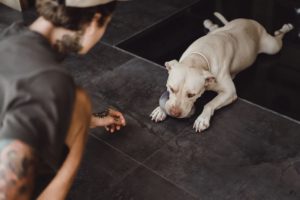Ask Crystal: Managing Separation Anxiety

Dear Crystal,
My puppy is now 15 weeks old. She is ok in the crate if she can see me. I had to leave her in the crate alone and returned an hour later to find her soaking wet. Literally dripping wet but it wasn’t urine. It was saliva. It’s hard to believe she could produce enough drool to soak herself and still be sitting in a puddle of it. I have tried leaving her with toys, with a bed, with treats and with nothing at all. Same thing happens every time. She also screams like a banshee most of that time. What can I do?
Sincerely,
Concerned Dog Mom
Dear Concerned,
That is certainly worrisome behavior. Her profuse drooling and screaming in the cage indicate severe levels of stress and anxiety. There are some potential reasons for this behavior that we need to do further investigation to figure out what the cause of the behavior is.
First, I am going to suggest that you no longer leave her in the crate when you leave.
The potential emotional trauma from being crated is not worth it. You need to find some way to confine her to a puppy proof location. That could mean using pens and baby gates to create a confinement area. You may use a bathroom or a part of a room like the kitchen. If she is small, she may be ok in a puppy pen. Some dogs with crate anxiety are better in a pen because they feel less enclosed. Many dogs prefer to be in a room with a baby gate rather than a shut door. If you have enough space, you could use an outdoor enclosure that you put inside. Those are usually a lot larger than crates.
If her issue is simply being confined, you may need to experiment with how large of an area she needs to feel comfortable. We may think that a room is plenty of space for a dog but the dog disagrees and feels better having the whole house. That is something you can find out with experimentation if that is the issue.
It is going to be very important that you find some way to watch her on camera to gather additional information that will be important for diagnosis. If you have a laptop, you can set up a zoom meeting between your laptop and phone if you don’t have a wireless camera. It is important to see her body language and how she is behaving so we can have more information. We need to see what level of stress behaviors she is exhibiting and how long it takes her to become stressed after you leave and how long she maintains that stressed behavior.
When doing this assessment, you don’t actually need to go anywhere, actually it is best of you do not. Your dog just needs to think you have gone somewhere. Walk outside and watch on the camera. Leave her as you normally would and watch her for signs of stress and anxiety. Time how long it takes her to become stressed. If she becomes very stressed and agitated, go ahead and go back inside so she doesn’t have a full-blown panic attack.
This type of behavior could potentially be separation distress or separation anxiety. Anxiety is the anticipation that something bad is going to happen because you aren’t there. The difference between the two is the level of stress that she feels. Separation anxiety is more like a panic attack and the reaction is very severe. Dogs will often injure themselves trying to get out of the crate or the house, all in an effort to find their person. Dogs have been known to destroy doors and break through windows trying to get out of the house. Some other symptoms could be destructive behavior around doors or windows, house soiling in an otherwise house-trained dog, barking, whining, pacing, panting and drooling.
Dogs with separation anxiety often also show signs of stress and anxiety when they notice the telltale signs that the owner is about to leave. You pick up your keys or put on your shoes and the dog starts to pace or whine.
These dogs tend to be clingy and they are hyper bonded to one person. That means that someone else could be with the dog and they still behave in the same way as if that person was not there. They only want their person. This makes true separation anxiety harder to treat than separation distress where the dog is ok if someone else is home with them.
Based on her age and the fact that she is mostly just drooling, I would guess she has a mild case of separation anxiety or distress. Puppies are at the greatest risk for developing separation related behaviors, especially when there is a sudden change in their routine to being left alone.

Exercise and enrichment go a long way in helping with anxiety. While it doesn’t get rid of it all together, it will often take the edge off so you can work with the dog. Scent work is a great low arousal way to burn energy in a dog. Other indoor activities could be round robin recalls, indoor agility, training exercises, indoor fetch, tug with rules and using a flirt pole. Snuffle mats are great choice for feeding and enrichment.
If she doesn’t have true separation anxiety, you can leave her in her area with food puzzles and other enrichment toys to help keep her busy while you are gone and help create a positive association. Dogs with separation anxiety often will not eat when left alone because they are too distressed.
Dogs with separation anxiety often are unable to be crated. They become too distressed at being left in a crate. It is best to address the separation issues first and stop leaving her in the crate. Later after you have gotten her used to being alone, you can revisit using the crate if you like.
When dogs have separation anxiety and are going through treatment, the owners are instructed that the dog cannot be left alone. We do not want to trigger the behavior. If she doesn’t have true separation anxiety, she should be ok being left with someone else. Maybe you have a neighbor that can watch her for you when you need to leave the house. If it’s just errands in your car or you are going to dog friendly places, you could bring her along. You could have a pet sitter come and sit with her or some pet sitters take dogs in their house. Dog daycare could be an option for when you need to leave all day.
The training for this type of anxiety involves extremely slow exposure to absences which the dog is able to tolerate and gradually as the dog is able increasing the times. In the beginning, the training works on the distance the person stands from the dog rather than a physical absence from the room and slowly increases that distance and rewards calm behavior. Leaving the room and eventually the house will be next steps as the dog is able.
- Teach her to accept being on a tether with you standing right next to her. When she is comfortable, take one step away and say “yes” before she has a chance to get upset and feed a treat. Repeat this step until you see no signs of anxiety at taking one step away.
- Gradually start to increase the length of time that you are one step away before saying, “yes” and treating. Keep practicing until she can remain relaxed while you stay one step away for a minute or longer. You will want to vary the time durations so she doesn’t become anxious at the exercise becoming continually more difficult. And you don’t want her to know how long you will be gone and we want her to learn that you will always return.
- Next take two steps away, say “yes” and immediately return to feed her a treat. Repeat at this distance until she is comfortable and gradually increase the time at this distance.
- Repeat the exercise at each new step until she is calm, then increase the time at each new distance. If she panics at any point, you have moved too quickly- go back and work at the previous distance until she is calm. You can also take a half step rather than a full step if needed.
- When she is calm while you walk to the other side of the room, sit down and read, you are ready for the next phase. Start the same way as before, but this time walk to the doorway to another room, step outside the room briefly, “Yes” and step back into the room before she has a chance to get upset. Return and reward. Repeat until she is calm about you stepping out of the room and gradually increase the length of time you remain out of sight.
- Next, sometimes close the door as you step out of the room, briefly at first and then for longer periods.
- Do the same exercise with each of the doors leading from the room, including the door that leads to the outside. Sometimes leave the door open, sometimes close it. Be sure to return and reward each time before your dog panics. If she starts acting anxious at any time, slow down and go back to a part of the exercise that she can tolerate. Then, when she is calm, slowly proceed to the step that upset
- Next, remove the tether and repeat Step 6, closing the door each time to prevent her from following you out of the room. Start with very brief departures. Gradually increase the length of time you are out of the room, but intersperse the longer times with shorter times so she never knows how long you will be gone.
- When she is comfortable with you stepping outside for several minutes, start adding bits of your departure routine to the exercise. Pick up your keys, step outside, return, “yes” and reward. Then put the keys down. Go outside, open and close the car door, then come back inside, “yes” and reward. As she gets better, add more pieces to the routine.
- The next step is to actually start the car engine, then come back inside and reward. Start the car engine, vary the amount of time you wait before coming back in to reward. Drive down the driveway, backhome, come back in and reward. Your goal is to gradually increase the length of time you can be outside to 30 minutes or more.
Be sure to proceed through each step only when the dog is comfortable. It’s better to do short successful sessions 5-10 minutes are way better than long sessions than end in frustration. You may be able to go through the steps in a week or two if your dog’s separation anxiety is mild, but it is more likely that it may take you several weeks, or months, to work up to 30 minutes.
Hopefully, since your dog is a puppy, you are catching this early enough to address it and keep it from becoming a larger problem. It will be very important that you work on this behavior now. This can be complicated to treat so if you need help, there are trainers that specialize in Separation Anxiety. Check out Malena DeMartini’s website for more information: Separation Anxiety Training Programs – Malena DeMartini
Until next time,
Crystal
Submit your own pet behavior question for Crystal here:







